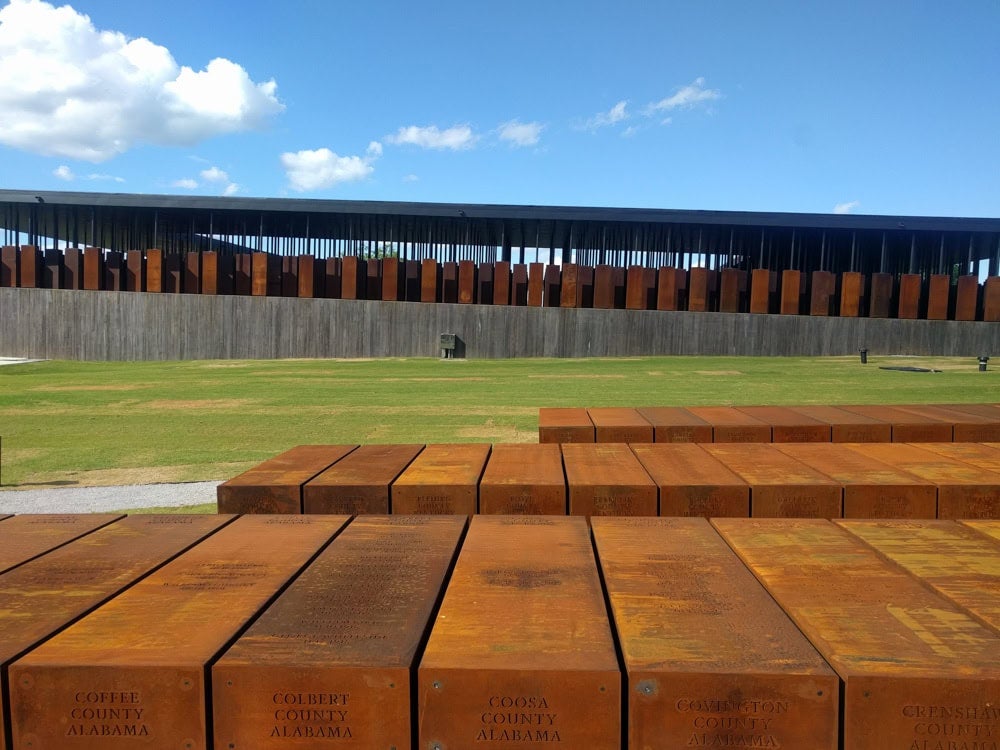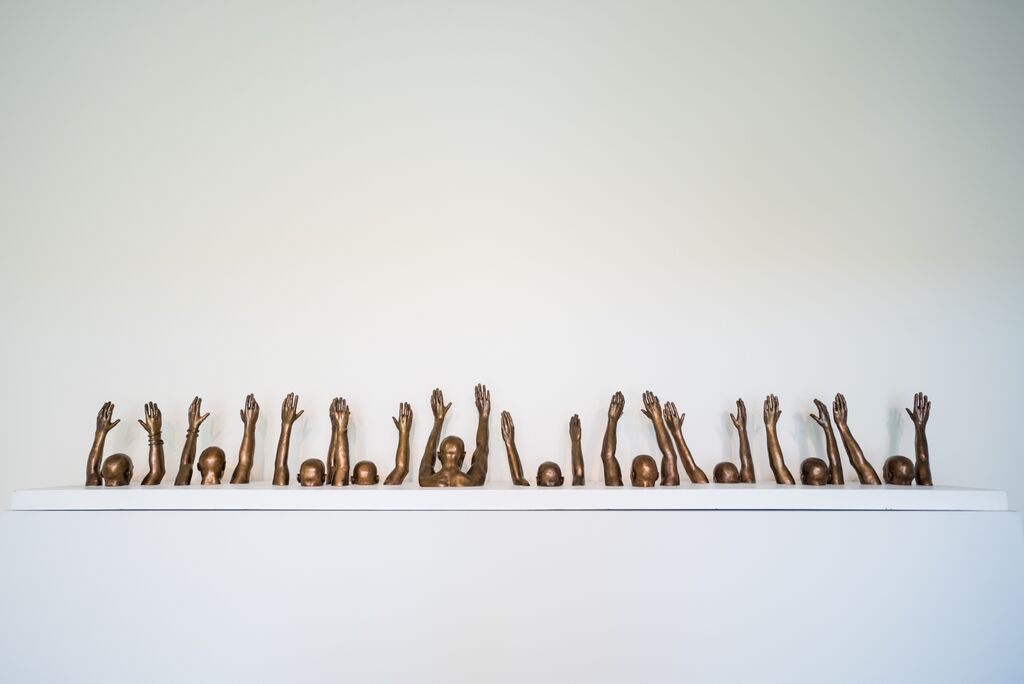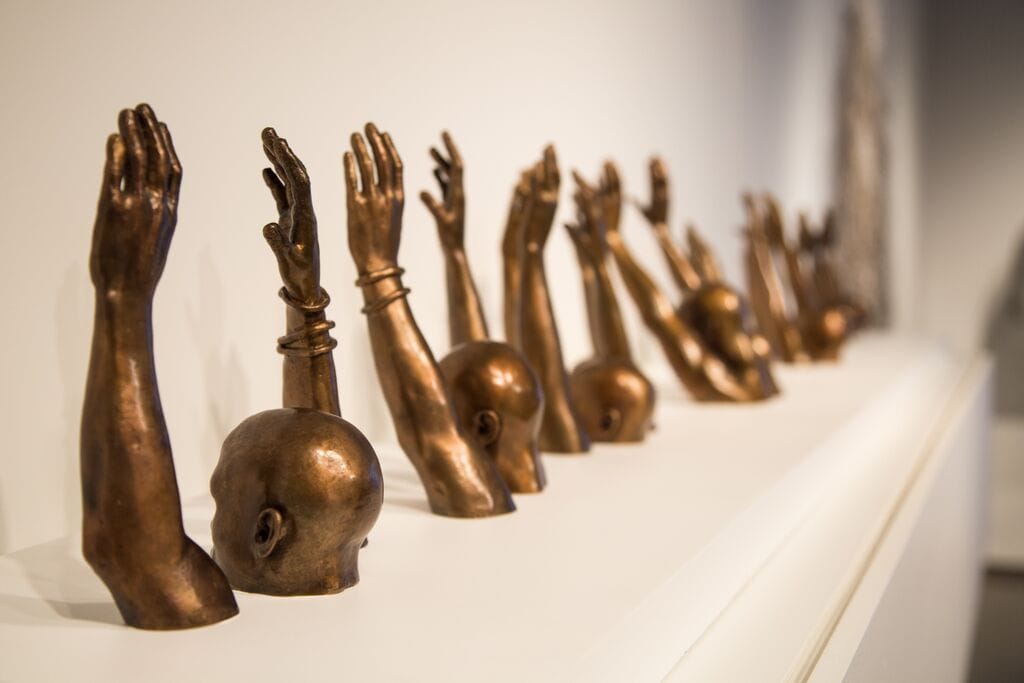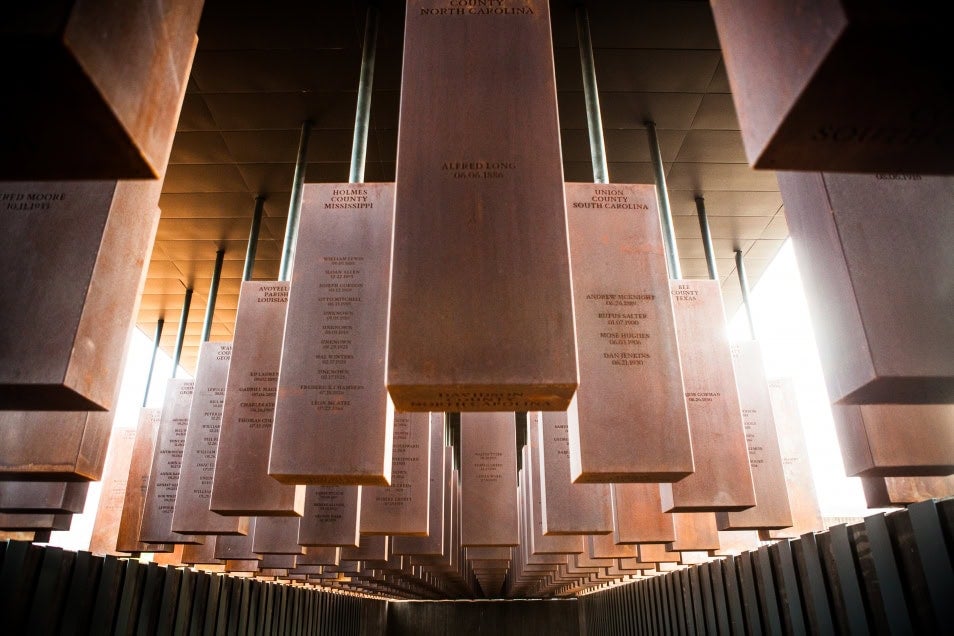
We asked Atlanta artist Masud Olufani to talk about his experience of and emotional response to the new National Memorial for Peace and Justice in Montogmery, Alabama. Read Rebecca Brantley’s coverage of the memorial here.
Montgomery, Alabama; Thursday, April 26, 2018
Visitors slow their pace. Voices fall to a whisper as though entering a reverential space: a church; a mosque; a temple. Sheets of light flood the subdued interior, illuminating pathways for the observant pilgrims. The floor begins a slow descent as the roof seems to rise, lifting 800 steel columns (suspended from the ceiling like “strange fruit” and inscribed with the names of the dead) heavenward. Currents of rust stream down the faces of the empty sarcophagi—tears of oxidation mourning the 4,400 lives lost — Charles Beal; David Cotton; Unknown; Wiley Johnson; Henry Askew; Unknown; Ike Anderson; Betsie McCray — and the killing fields, places consecrated by the blood of the innocent— Ellis County, Texas; Ascension Parish, Louisiana; Grenada, Mississippi; Craven County, North Carolina; Spartanburg County, South Carolina; Stewart County, Tennessee; Phillips County, Arkansas; Butts County, Georgia. I am standing in a hall of remembrance, a six-acre site in the heart of Montgomery, Alabama, made sacred by a symbolic gathering of names and places tied to an unspeakable horror— lynching in America.
I had traveled to this historic city, which once served as the first capital for the Confederate States of America, at the invitation of the Equal Justice Initiative (the human rights organization founded by defense attorney Brian Stevenson), to celebrate the completion of the nation’s first memorial to the victims of racialized violence. I had traveled here as a multidisciplinary artist to see how form, function, memory, meaning and metaphor had been manipulated to provide context to a painful and challenging history. I had traveled here to intone the names of the dead, to reflect on the lives lost and on the disgraceful code of silence that sanctioned the brutal practice of lynching, claiming thousands of victims between 1877 and 1981. I had traveled here to wrestle with the sobering realization that in 2018 the black body still occupies a precarious place in our society strangely reminiscent of a time a delusional society would rather forget.
Kwame Akoto-Bamfo’s powerful sculpture Nkyinkyim, depicting six shackled Africans, startles me as I begin the slow ascent up the paved walking path to the memorial’s entrance. The life-sized bronze figures, including men and women (one holding a child) strike defiant poses as they struggle against the imposed immobility of their restraints. The work is a literal interpretation of the “institution” that laid the groundwork for what was to come. Conceptually, it represents the starting point, the ideological fissure that objectifies and dehumanizes, making lynching in our recent past, and the disproportionate rate at which black people are murdered by the police in our present, not only possible, but in some sense, inevitable. It’s an important and sobering point to make — poignant and deeply moving.
The central element of the memorial — designed by the Boston-based architectural firm MASS Design Group — sits on a gently sloped hilltop freshly manicured with young sod. It’s a large hall-like structure — boxlike in its configuration — that leads visitors through a cavernous space filled with hundreds of monolithic Cor-ten steel columns, each engraved with the location of a documented lynching and the name of the victims. The coffin-shaped structures are arranged sequentially in a gridded format, each tethered to the ceiling by a rigid steel post. At the entrance to the memorial, the columns are anchored to the floor, like giant headstones marking the site of the condemned innocent. Moving through the building, I notice that the angle of the floor began to slope downward, subtly, gradually, freeing the columns from their earthbound moorings. The roofline remains fixed while I descend, creating the illusion that the totemic monoliths are rising as though pulled by some unseen force. The architectural sleight-of-hand is a powerful trick suggesting the transcendent nature of the soul and the revivalist traditions of the black church. What was static has become mobile. What was dead has arisen. What was hidden is now known. As the great poet William Cullen Bryant so eloquently stated: “truth crushed to earth shall rise again.”

As the floating coffins reach their zenith, the once crowded floor empties, allowing for the free flow of visitors, who gaze upward towards the ascending “angels.” A thin sheet of water cascading down a far wall augments the sense of loss, of reclamation, and rebirth. It is a libation for the dead; a baptism; a cleansing. At the heart of the building, an open-air courtyard at the hill’s crest allows a moment for contemplation and reflection. It is a welcome feature of the design — a point of rest from the emotional impact of the interior space. As I exit the building, I am struck by a quote from Toni Morrison’s astonishing novel Beloved that is inscribed on an exterior wall. It is an excerpt from a sermon delivered by Baby Suggs (the matriarchal moral center of the novel) to a secret gathering of enslaved African Americans:
“And O my people, out yonder, hear me, they do not love your neck unnoosed and straight. So love your neck; put a hand on it, grace it, stroke it and hold it up, and all your inside parts that they’d just as soon slop for hogs, you got to love them. The dark, dark liver—love it, love it and the beat and beating heart, love that too.”
The quote is brilliantly chosen and skillfully placed. It’s a declarative statement — an affirmation of one’s humanity in the face of sustained brutality and cruelty.

On the park grounds surrounding the building, identical markers to those within the memorial’s interior have been placed horizontally on the lawn. Arranged in sequential order, they have been grouped according to the state in which each lynching took place. This is a clever choice as it allows one to survey all of the recorded killings in a given state and the counties in which they occurred. The effect of seeing hundreds of steel “coffins” placed on the gently sloping lawn is like witnessing a mass burial site, similar, in some sense, to the burial grounds in Normandy, France, or the National Cemetery in Washington, D.C. It is a startling reminder of the scope of the loss, and that although the victims were almost exclusively black, the legacy of the tragedy is for the nation to bear.
Perhaps the most ingenious feature of the memorial is its mobility. Each one of the duplicate markers will be offered to the county it represents for placement in the ground near the lynching site. The hope is that eventually all 800 markers will be permanently installed in the corresponding locations, making the memorial a roving visual reminder of one of the most tragic periods in the nation’s history. It will also serve as a test of our willingness to face the complexities of our racialized past and pursue a path of deep and sustained healing — a healing that must be earned through the crucible of truth.
As I left the grounds of the memorial, I was filled with a deep and abiding sense of gratitude for the work and vision of Brian Stevenson and his dedicated and committed colleagues at the Equal Justice Initiative. I was encouraged to see the diverse crowds navigate their way through the park grounds, an affirmation that human tragedy may be localized, occurring in a particular place and time, but its impact is global. I was also reminded of the transformative power of art — its ability to clarify and heal when the intention is directed towards service to humanity. The memorial is a visceral rendering of an enduring national scar, and yet, when we muster the courage to examine the wound, to treat it, we find that in the end we have healed not only the wounded “other” but ourselves as well.

Truthfulness, uprightness and integrity are the attributes of the righteous and the hallmarks of the pure. Truthfulness is the goodliest of qualities as it comprehendeth all other virtues. A truthful person will be protected from all moral afflictions, will shrink from every evil deed, and be preserved from every wicked act, inasmuch as all vices and misdeeds are the very antithesis of truthfulness, and a truthful man will hold them all in utter abhorrence.
‘Abdu’l-Bahá, from a Tablet, translated from the Persian




